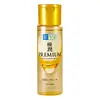What's inside
What's inside
 Key Ingredients
Key Ingredients

 Benefits
Benefits

 Concerns
Concerns

No concerns
 Ingredients Side-by-side
Ingredients Side-by-side

Water
Skin ConditioningButylene Glycol
HumectantHydroxyethyl Urea
HumectantPPG-10 Methyl Glucose Ether
Skin ConditioningDiglycerin
HumectantSodium Hyaluronate
HumectantHydrolyzed Hyaluronic Acid
HumectantSodium Acetylated Hyaluronate
HumectantHydroxypropyltrimonium Hyaluronate
Sodium Hyaluronate Crosspolymer
HumectantLactobacillus/Sodium Hyaluronate Ferment Filtrate
EmollientHydrolyzed Sodium Hyaluronate
Skin ConditioningSaccharide Hydrolysate
HumectantHydrogenated Starch Hydrolysate
HumectantGlycosyl Trehalose
Emulsion StabilisingSorbitol
HumectantTriethyl Citrate
MaskingPEG-32
HumectantCarbomer
Emulsion StabilisingPEG-75
HumectantDisodium Succinate
MaskingPropanediol
SolventDiethoxyethyl Succinate
SolventPotassium Hydroxide
BufferingSuccinic Acid
BufferingDisodium EDTA
Polyquaternium-51
Skin ConditioningCaprylhydroxamic Acid
Hydroxyethylcellulose
Emulsion StabilisingXanthan Gum
EmulsifyingPhenoxyethanol
PreservativeWater, Butylene Glycol, Hydroxyethyl Urea, PPG-10 Methyl Glucose Ether, Diglycerin, Sodium Hyaluronate, Hydrolyzed Hyaluronic Acid, Sodium Acetylated Hyaluronate, Hydroxypropyltrimonium Hyaluronate, Sodium Hyaluronate Crosspolymer, Lactobacillus/Sodium Hyaluronate Ferment Filtrate, Hydrolyzed Sodium Hyaluronate, Saccharide Hydrolysate, Hydrogenated Starch Hydrolysate, Glycosyl Trehalose, Sorbitol, Triethyl Citrate, PEG-32, Carbomer, PEG-75, Disodium Succinate, Propanediol, Diethoxyethyl Succinate, Potassium Hydroxide, Succinic Acid, Disodium EDTA, Polyquaternium-51, Caprylhydroxamic Acid, Hydroxyethylcellulose, Xanthan Gum, Phenoxyethanol
Water
Skin ConditioningGlycerin
HumectantDipropylene Glycol
HumectantPentylene Glycol
Skin ConditioningUrea
BufferingCeramide Ng
Skin ConditioningSodium Hyaluronate
HumectantSodium Acetylated Hyaluronate
HumectantHydrolyzed Hyaluronic Acid
HumectantHydroxyethyl Urea
HumectantCirsium Flower/Leaf/Stem Extract
Skin ConditioningAnthemis Nobilis Flower Extract
MaskingErica Cinerea Flower Extract
Skin ConditioningCalendula Officinalis Flower Extract
MaskingCentaurea Cyanus Flower Extract
AstringentPyrus Malus Fruit Extract
Skin ConditioningPrunus Persica Leaf Extract
EmollientPimpinella Anisum Fruit Water
Skin ConditioningDipotassium Glycyrrhizate
HumectantSodium Citrate
BufferingLactic Acid
BufferingButylene Glycol
HumectantPPG-4-Ceteth-20
EmulsifyingAlcohol Denat.
AntimicrobialPhenoxyethanol
PreservativeWater, Glycerin, Dipropylene Glycol, Pentylene Glycol, Urea, Ceramide Ng, Sodium Hyaluronate, Sodium Acetylated Hyaluronate, Hydrolyzed Hyaluronic Acid, Hydroxyethyl Urea, Cirsium Flower/Leaf/Stem Extract, Anthemis Nobilis Flower Extract, Erica Cinerea Flower Extract, Calendula Officinalis Flower Extract, Centaurea Cyanus Flower Extract, Pyrus Malus Fruit Extract, Prunus Persica Leaf Extract, Pimpinella Anisum Fruit Water, Dipotassium Glycyrrhizate, Sodium Citrate, Lactic Acid, Butylene Glycol, PPG-4-Ceteth-20, Alcohol Denat., Phenoxyethanol
 Reviews
Reviews

Alternatives
Ingredients Explained
These ingredients are found in both products.
Ingredients higher up in an ingredient list are typically present in a larger amount.
Butylene Glycol (or BG) is used within cosmetic products for a few different reasons:
Overall, Butylene Glycol is a safe and well-rounded ingredient that works well with other ingredients.
Though this ingredient works well with most skin types, some people with sensitive skin may experience a reaction such as allergic rashes, closed comedones, or itchiness.
Learn more about Butylene GlycolHydrolyzed Hyaluronic Acid is a form of hyaluronic acid. It is created by the hydrolysis of hyaluronic acid with a high molecular weight. Once created, Hydrolyzed Hyaluronic Acid has a low molecular weight.
Low molecular weight HA has been shown to hydrate and increase elasticity of the skin. Increasing elasticity is also associated with reduction of wrinkle depth.
One study found topical low molecular weight hyaluronic acid may be considered for the treatment of rosacea in the adult population. However, we always recommend speaking with a professional about your skin concerns.
Hyaluronic acids are a humectant. This means they draw moisture from the air. Hyaluronic acids help moisturize, soothe, and protect the skin.
Read more about other common forms of hyaluronic acid:
Learn more about Hydrolyzed Hyaluronic AcidPhenoxyethanol is a preservative that has germicide, antimicrobial, and aromatic properties. Studies show that phenoxyethanol can prevent microbial growth. By itself, it has a scent that is similar to that of a rose.
It's often used in formulations along with Caprylyl Glycol to preserve the shelf life of products.
Sodium Acetylated Hyaluronate is a type of Hyaluronic Acid.
Hyaluronic Acids help moisturize, soothe, and protect the skin.
Read about common types of Hyaluronic Acid here:
Sodium Hyaluronate
Hydrolyzed Hyaluronic Acid
Hyaluronic Acid
Sodium Hyaluronate is hyaluronic acid's salt form. It is commonly derived from the sodium salt of hyaluronic acid.
Like hyaluronic acid, it is great at holding water and acts as a humectant. This makes it a great skin hydrating ingredient.
Sodium Hyaluronate is naturally occurring in our bodies and is mostly found in eye fluid and joints.
These are some other common types of Hyaluronic Acid:
Learn more about Sodium HyaluronateWater. It's the most common cosmetic ingredient of all. You'll usually see it at the top of ingredient lists, meaning that it makes up the largest part of the product.
So why is it so popular? Water most often acts as a solvent - this means that it helps dissolve other ingredients into the formulation.
You'll also recognize water as that liquid we all need to stay alive. If you see this, drink a glass of water. Stay hydrated!
Learn more about Water